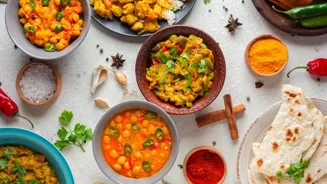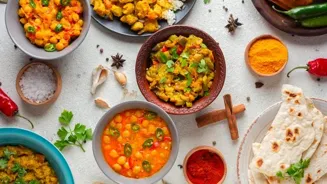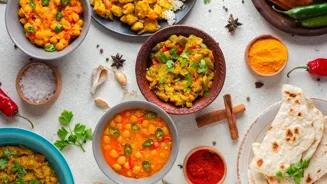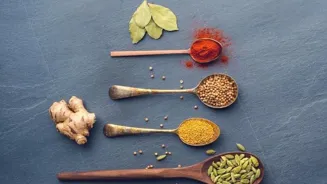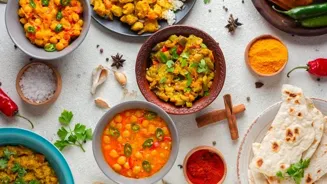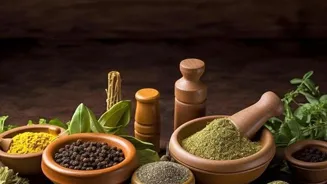Unveiling the Art of Indian Curry: Dive into the secrets behind the perfect recipe. Spice up your cooking! Read more
Namaste, food lovers! Ever wondered what makes Indian curry so lip-smackingly delicious?
It's not just about throwing a few spices together, oh no! It’s an art, a science, and a whole lot of love simmered into one comforting dish.
From the snowy peaks of the Himalayas to the sunny beaches of Goa, every region in India boasts its own unique curry, each with a story to tell. So, grab your apron, and let’s dive into the secrets behind creating that perfect curry.
We will explore the foundation of every great curry, the spice blend, and how to build it.
Indian curry's essence lies in diverse masala blends, each unique
The heart and soul of any Indian curry lie in its “masala,” the spice blend. This is where the magic truly begins. Think of masala as the artist's palette, with each spice contributing a unique color and texture to the final masterpiece. No two masalas are ever exactly alike!
Some are fiery and bold, packed with chilies and peppercorns, perfect for those who like a bit of a kick. Others are warm and fragrant, featuring cinnamon, cardamom, and cloves, creating a soothing, aromatic experience.
Then you have the earthy blends, grounded in coriander, cumin, and turmeric, offering a hearty and wholesome flavour. Begin with familiarising yourself with the basic spices: turmeric (haldi), coriander powder (dhania), cumin powder (jeera), red chili powder (lal mirch), and garam masala.
Garam masala is itself a blend, typically including cinnamon, cardamom, cloves, and black peppercorns. This is your core team ready.
Fresh spices, toasting before grinding enhance aroma and taste
The quality of your spices matter a lot. Always opt for fresh, whole spices whenever possible. Toasting before grinding is also a game-changer. Toasting the spices lightly in a dry pan before grinding releases their essential oils, enhancing aroma and taste.
Think of it like waking them up, making them more vibrant. For instance, cumin and coriander seeds respond beautifully to toasting, releasing a toasty, nutty aroma. Don’t burn them, a light browning is enough. Experiment. Once you are comfortable with the basic spices, start experimenting!
Add fenugreek leaves (kasuri methi) for a slightly bitter, savory note, or amchur powder (dried mango powder) for a tangy twist. Adjust the quantities of each ingredient to suit your personal taste. Don't be afraid to be bold. Curry is a journey, not a destination.
You might add some fennel seeds or ajwain as per your needs.
Mastering curry: bloom spices, sauté aromatics, add tomatoes for flavor
The next step in mastering the art of curry is understanding the building process. It's not just about dumping all the ingredients into a pot at once. Oh no, there's a method to the madness! The first step, and a key step, is blooming the spices.
This involves gently frying the ground spices in oil or ghee (clarified butter) at low heat and in low flame to awaken their flavours and release aroma. This step is crucial; don't skip it. It can transform a bland curry into a flavourful explosion.
Fry them just long enough to release their aroma, but be careful not to burn them. Next, add your aromatics – ginger, garlic, onions, and green chilies. These form the foundation of the curry’s flavour profile. Sauté them until they are soft and golden brown, releasing a sweet aroma.
Tomatoes are often added next, cooked down until they form a thick paste.
Layer vegetables, simmer slowly to enhance flavors in curry
Next comes the layering of the vegetables. Add your core vegetables like potatoes cauliflower and green peas. Add some other veggies depending on availability. Add water according to need and bring it to a gentle boil. Simmer slowly and allow them to soak in the other flavours.
Take your time, and allow flavours to meld. This is where the magic of slow cooking comes into play. The longer you simmer the curry, the richer and more complex the flavours become. Check the seasoning.
A perfectly seasoned curry is a joy from within, and the cornerstone to a perfect curry is seasoning.
Tips for thickening curry naturally without altering flavor
Now, let's talk about thickening your curry. Some people prefer a very thick gravy, while others opt for a thinner, more soupy consistency. There are plenty of natural ways to thicken it like: Pureeing some of the cooked vegetables and stirring it back into the curry is a great thickening option.
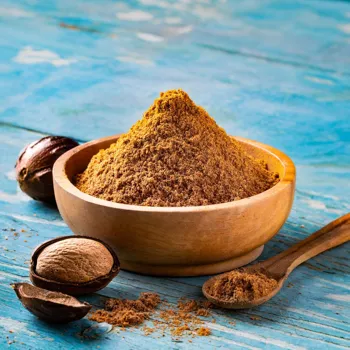
A spoonful of besan (gram flour) or cornstarch (mixed with water) can also be used as a thickener. Be careful not to add too much, as it can alter the flavor. Finally, garnish your curry with fresh coriander leaves or a dollop of fresh cream. This adds a pop of colour and a touch of freshness.
Remember, presentation is key.
Unlock the secrets to perfect Indian curry through experimentation and creativity
And there you have it! The secrets behind the perfect Indian curry revealed. Remember, cooking is all about experimentation, so don't be afraid to get creative. Try different spice combinations, variations of vegetables, and discover your own perfect curry recipe.
Keep practicing and soon you become the master of the curry. Enjoy the cooking, enjoy the food and enjoy sharing it with family and friends. It is not just a meal, it is a celebration. The art of Indian curry is a journey for everyone. Take it slow and relish it.
AI Generated Content. Glance/InMobi shall have no liability for the content